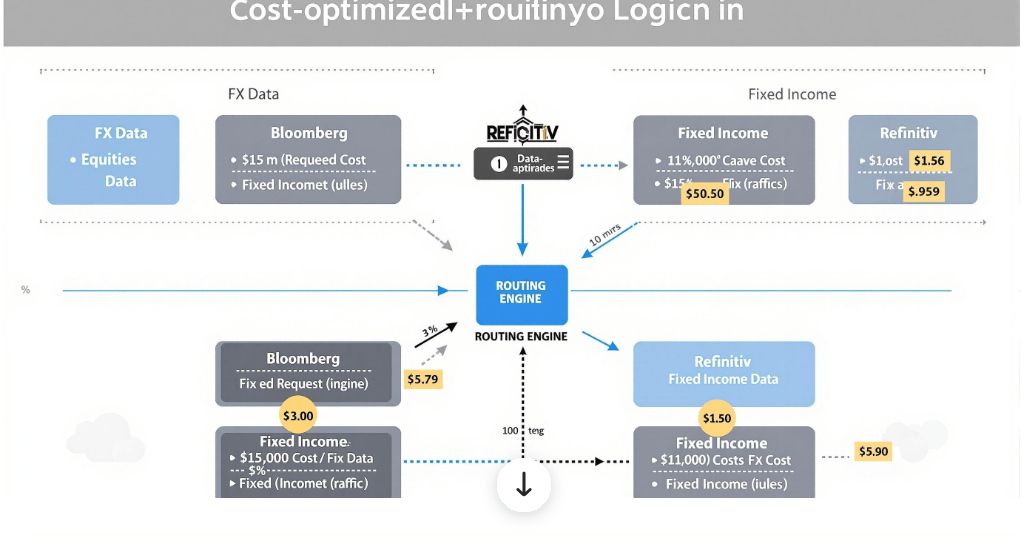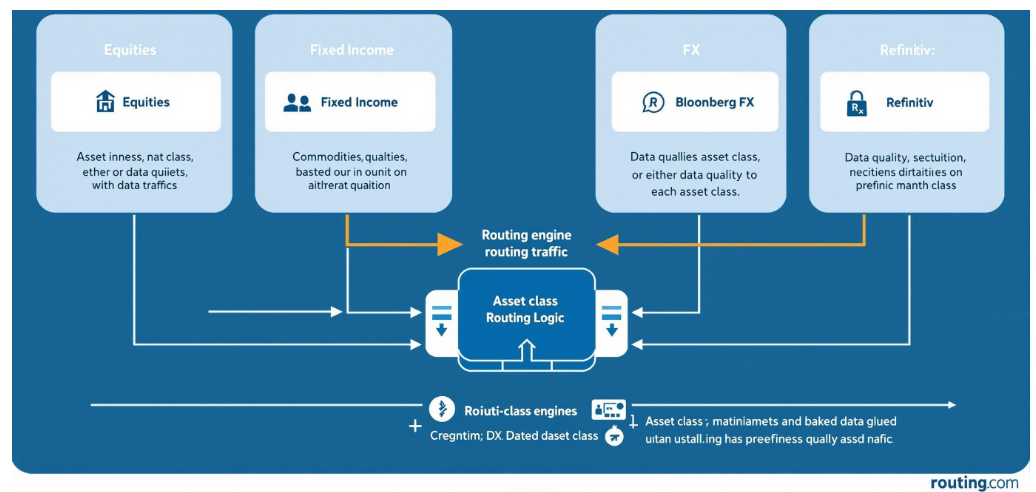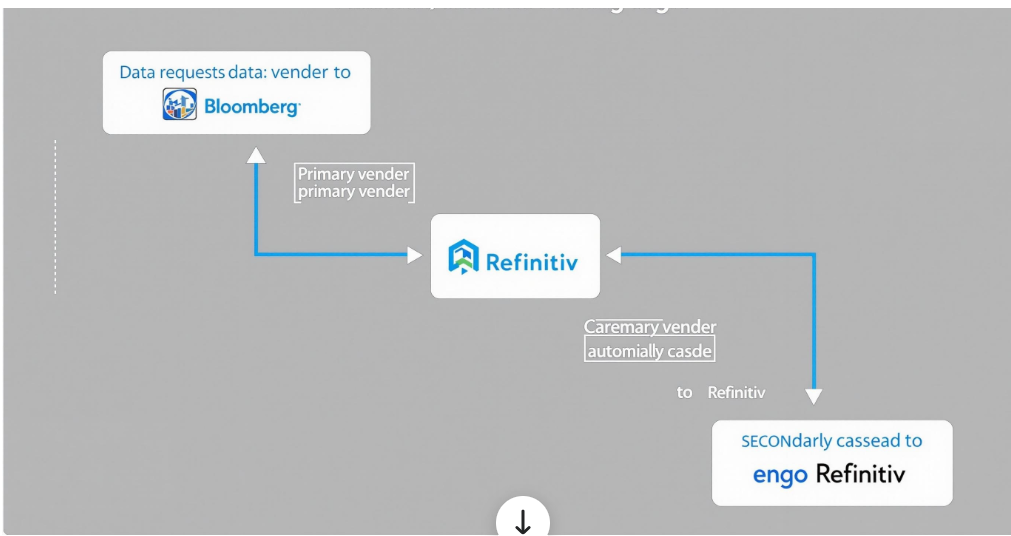Optimizing Market Data Costs with Smart Vendor Routing Strategies
5/1/20255 min read


Optimizing Market Data Costs with Smart Vendor Routing Strategies
In today's financial services landscape, market data costs represent a significant expense for many organizations. Firms often subscribe to multiple vendors like Bloomberg and Refinitiv, yet most utilize only basic routing logic that fails to maximize value from these substantial investments. A more sophisticated routing system can dramatically reduce costs while ensuring data quality and availability remain uncompromised.
The Hidden Cost of Simplistic Routing
Many financial firms currently employ elementary data retrieval logic:
If data exists in Bloomberg → Get from Bloomberg Else → Get from Refinitiv
This simplistic approach overlooks opportunities to optimize both costs and data quality. With market data subscriptions often running into hundreds of thousands or even millions of dollars annually, implementing smarter routing strategies offers substantial ROI potential.
Three Smart Routing Strategies That Reduce Costs
Let me explore three sophisticated routing approaches that can transform how your organization consumes market data:
1. Cost-Optimized Routing Logic
This strategy automatically routes data requests to the vendor with the lowest cost for each specific data type, helping organizations minimize their overall market data expenses.


Key features illustrated:
Central routing engine that evaluates cost per data type
Different data types (FX, Equities, Fixed Income) being directed based on cost efficiency
Price indicators showing comparative costs between vendors
Cost-based decision making that prioritizes the most economical source
This approach is ideal for organizations that want to maximize cost savings while maintaining necessary data coverage across their operations.
How it works:
The system maintains a routing table mapping data types to the most economical vendor
Requests are automatically directed to whichever vendor offers the lowest cost for that particular data type
Example: Refinitiv might provide FX data at lower cost while Bloomberg offers more economical equities data
Benefits:
Immediate cost savings through automated selection of the cheapest vendor for each request
Optimization without sacrificing data quality
Dynamic adjustment as vendor pricing models evolve
2. Asset Class Routing Logic
This approach recognizes that different vendors excel in different asset classes:


Key features illustrated:
Central routing engine with predefined asset class rules
Different asset classes (Equities, Fixed Income, Commodities, FX) with associated icons
Clear routing paths showing which vendor is preferred for each asset class
Quality-based decision making that prioritizes data excellence
This approach works best for organizations that require specialized data quality for different parts of their investment or analysis processes.
Example routing rules:
Equities → Bloomberg (higher quality, more comprehensive)
Fixed Income → Refinitiv (better coverage)
Commodities → Bloomberg (more timely updates)
FX → Refinitiv (wider coverage of currency pairs)
Benefits:
Ensures optimal data quality for each asset class
Leverages the strengths of each vendor
Provides balance between cost and quality considerations
Creates a specialized approach that aligns with your investment focus
3. Fallback/Cascade Logic
This reliability-focused strategy provides redundancy while maintaining cost control:


Key features illustrated:
Central routing engine managing the fallback process
Primary path to Bloomberg with success/failure decision point
Secondary path to Refinitiv activated only when primary source fails
Waterfall/cascade effect showing the sequence of attempts
Visual indicators for success and failure paths
This approach prioritizes data availability and system resilience while still maintaining vendor preferences where possible.
How it works:
Attempt to fulfill the request from the preferred vendor first
If data is unavailable or the request fails, automatically retry with secondary vendor
Can be configured with more than two levels for critical data
Benefits:
Ensures maximum data availability
Reduces manual intervention when primary source fails
Maintains business continuity during vendor outages
Provides peace of mind for mission-critical applications
The Compound Benefits of Smart Routing
Implementing these strategies creates multiple advantages:
Direct Cost Reduction - By routing each request to the optimal vendor, firms typically see 15-30% reduction in data costs
Improved Negotiating Position - With usage metrics across vendors, firms gain leverage in contract negotiations
Enhanced Data Quality - By routing to vendors with strengths in specific asset classes, overall data quality improves
Operational Efficiency - Automated routing reduces manual interventions and streamlines workflows
Contract Optimization - Usage analytics provide insights that help right-size future contract renewals
Implementation Considerations
While the benefits are clear, implementing sophisticated routing requires careful planning:
Vendor Contract Analysis - Understanding the detailed pricing structures of each vendor
Data Quality Assessment - Evaluating which vendor provides superior data for each asset class
Technical Integration - Building the routing layer that sits between applications and vendors
Performance Optimization - Ensuring the routing system doesn't create latency issues
Ongoing Governance - Regular review of routing rules as market conditions and vendor offerings change
How Juju Consulting Group Can Help
At Juju Consulting Group, we specialize in helping financial firms optimize their market data infrastructure. Our team of experts combines deep market data expertise with technical implementation capabilities to deliver customized vendor routing solutions that maximize ROI.
Our approach includes:
Comprehensive Vendor Assessment - We analyze your current contracts, usage patterns, and costs to identify optimization opportunities
Tailored Routing Strategy - We develop routing rules customized to your specific requirements and vendor landscape
Technical Implementation - Our engineers build and deploy the routing layer with minimal disruption
Monitoring & Optimization - We provide ongoing support to ensure continued optimization as conditions change
ROI Measurement - We track and report on the actual savings achieved
Taking the Next Step
Market data costs will continue to rise, but smart routing strategies provide a powerful tool to control these expenses without sacrificing quality or availability. By implementing a sophisticated routing system, your organization can achieve immediate cost savings while positioning itself for long-term market data optimization.
Contact Juju Consulting Group today to learn how we can help your organization implement these strategies and start realizing the benefits of intelligent market data routing.
We Want to Hear from You
Are you currently implementing a market data routing strategy at your organization? We're interested in learning about your approach:
Do you use one of the strategies outlined above? Perhaps you've implemented a cost-optimized, asset-class based, or fallback routing system. We'd love to hear about your experiences, challenges, and the benefits you've realized.
Using a different approach altogether? If you've developed an alternative routing strategy that works well for your organization, we're eager to understand how it functions and what advantages it provides.
Still using basic routing logic? If you're currently using simple routing rules but considering an upgrade, what barriers or concerns are you facing in implementing a more sophisticated approach?
No routing strategy in place yet? If you're managing multiple data vendors without a formal routing strategy, what challenges are you experiencing?
Share your experiences with us at Juju Consulting Group. Your insights help us refine our approaches and develop better solutions for the market data community. Contact us today to join the conversation and learn how other organizations are tackling similar challenges.
